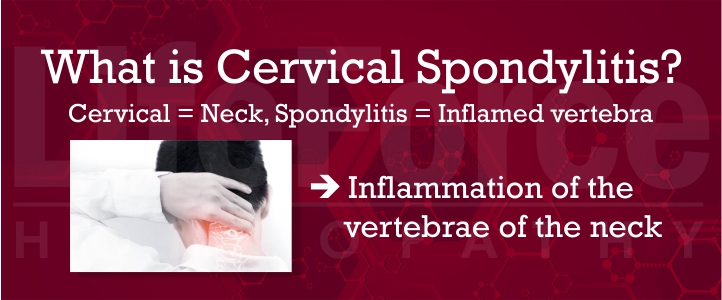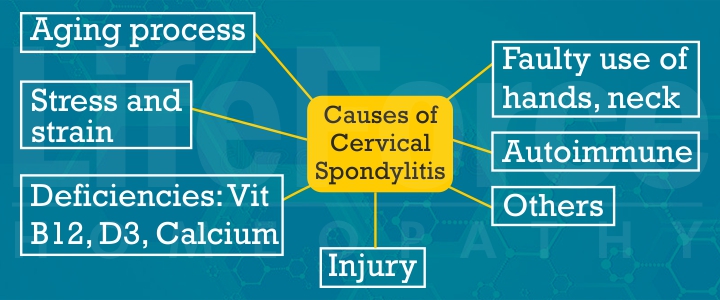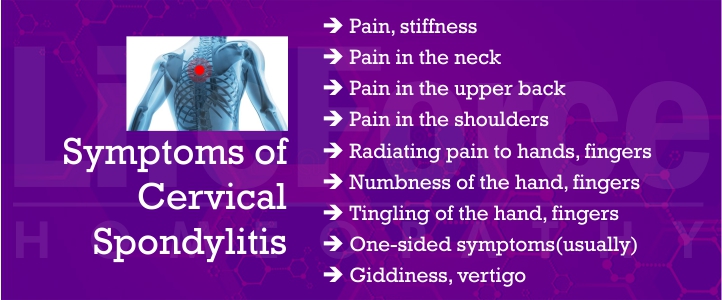What Is Cervical Spondylitis?
Cervical spondylitis occurs due to the degeneration (wear and tear on account of aging) of the vertebrae, intervertebral discs, and ligaments in the neck or cervical spine. Nowadays, using computers and smartphones for a long time is one of the most common causes of cervical spondylitis in young people.

Cervical spondylitis is also known as arthritis of the neck, degenerative osteoarthritis, or cervical osteoarthritis.
The cervical spine starts at the base of the skull bone. The cervical spine (neck) consists of seven vertebrae (bones). Intervertebral discs separate these vertebrae. Intervertebral discs contain a gel-like substance that functions as a cushion between the vertebrae. Various muscles and ligaments are attached to the vertebrae that help in the smooth movement of vertebrae.
Nerves from the spinal cord pass through the vertebrae and reach your shoulders, neck, arms, and upper chest. The cervical spine stabilizes the neck and allows the smooth movements of your neck from side to side, forwards, and backwards. The function of the cervical spine is like a shock absorber, and it helps in maintaining body posture. Over a period, as your age advances, this natural shock absorber starts to degenerate.
In cervical spondylitis, the intervertebral discs get thinner, dehydrated, and lose their ability to absorb a shock. The edges of the vertebrae develop bone spurs known as osteophytes.
Initially, the patients may not experience symptoms at all, while a few may experience pain and stiffness in the neck, shoulder, and hands. These symptoms occur due to the inflammation of soft tissues and ligaments between the vertebrae and due to the formation of osteophytes.
Later, these changes can put pressure on nearby nerve roots resulting in pain, tingling sensation, or numbness in the upper extremities.
The degeneration of vertebrae, intervertebral discs, and abnormal growth (osteophytes), later, can cause narrowing of the spinal column (opening where spinal nerves exit) leading to a condition called cervical spinal stenosis or spinal canal stenosis.
Homeopathic Treatment For Cervical Spondylitis:
Homeopathy is highly recommended for chronic diseases like cervical spondylitis. An individualized approach in homeopathy is highly effective in treating cervical spondylitis and that too without any side effects.

How homeopathy can help in Cervical Spondylitis?
- Homeopathy provides you effective relief in pain and stiffness of the cervical spine.
- Homeopathic medicines reduce the inflammation of the disc and ligaments.
- Hence, homeopathy improves the mobility of your neck and hands.
- If a patient has nerve root compression, the regular use of homeopathic medicines shows improvement in the relief from tingling sensation and numbness.
- Homeopathic medicines are deep-acting and, hence, they control the further process of degeneration. Homeopathy controls the progression of the disease and prevents further destruction of the disc and vertebrae to some extent.
- Gradually, homeopathy reduces the need for painkillers. Eventually, you can stop taking painkillers.
- Homeopathy is safe, non-toxic, and non-habit-forming even when taken for a long duration.
- If augmented with physiotherapy, yoga, and other measures, homeopathy shows excellent results in cervical spondylitis.
Duration Of Treatment:
Many patients experience symptomatic relief in cervical spondylitis in the initial four to six weeks. The total duration of treatment depends on various factors like:
- The extent and progress of the disease: Intensity of inflammation, degeneration, and compression.
- The duration of suffering.
- Age of the patient.
- The general health of the patient.
- Occupation and lifestyle of the patient.
- Any other underlying medical condition.
What are the chances of recovery in cervical spondylitis with homeopathy?
- Excellent result: In early and mild cases of cervical spondylitis, one may find a quick and excellent result. The patients of younger age groups or youths respond well to homeopathic treatment.
- Good result: Good results are observed in moderate to severe cases of cervical spondylitis.
- Not so good result: Very severe and very old cases may not show good results. A few severe cases may not respond at all.
Commonly prescribed homeopathic medicines in cervical spondylitis
Some of the commonly prescribed homeopathic medicines for cervical spondylitis are Lachnanthes Tinctoria, Kali Carb, Silicia, Phosphoric Acid, Paris Quadrifolia, Kalmia Latifolia, Causticum, etc.
The specific symptoms of the above-mentioned remedies indicated in cases of cervical spondylitis:
1) Lachnanthes tinctoria: This remedy is indicated for cervical spondylitis when the stiffness in the neck is prominent and severe to the extent that one is unable to move the neck, and the movements are restricted. The pain is intense and often described as tearing or shooting in nature. There is the sensation of tightness or tension in neck muscles because of which individuals find it difficult to turn their heads. The sudden movements of the neck may exacerbate the pain. The symptoms improve with rest. The pain in the neck radiates towards the arms and may be associated with dizziness and headache.
2) Kali Carb (Kali Carbonicum): The symptoms of Cervical spondylitis in individuals needing Kali carb are heaviness in the neck as the neck is weighted down. They experience neck cracking or popping sensations with the movements, especially when attempting to turn the head. The pain in the neck radiates toward the shoulders and there is the sensation of tension or tightness in the muscles of the shoulder girdle. The neck muscles feel weak making one to support the head properly. The pain in the neck is worse by exposure to cold weather and you may find relief using warm compresses. The pain becomes worse at night making it difficult to sleep. The Kali carb is suitable for individuals who are anxious by nature get easily fatigued and also present with digestive or respiratory issues.
3) Silicea (Silica): It is indicated for Cervical spondylitis when there is weakness and debility in neck muscles, leading to difficulties in supporting the head properly. This weakness may contribute to or exacerbate the cervical spondylitis symptoms. It is often prescribed when there is an affinity for glandular swellings in the neck contributing to discomfort or stiffness in the neck. They are sensitive to cold temperatures and feel better in warm environments. There is the sensation of grating or cracking in the neck joints during neck movement.
4) Phosphoric acid (Phosphoricum acidum): It is a best-suited remedy for Cervical spondylitis wherein the pain is worse with mental or physical exertion. They do experience increased discomfort in the neck after prolonged periods of physical activity or mental exertion. There is profound weakness in neck muscles or a general feeling of fatigue. The neck pain and stiffness may be linked to emotional strain or loss. The pain is worse at night, especially after lying down.
5) Paris quadrifolia: It is indicated when there is stiffness and pain in the cervical spine, especially in the back of the neck. Pain originating in the neck might travel towards the shoulders and upper back, coupled with a feeling of tightness or tension in the muscles surrounding the neck and shoulders. They do experience a sensation of heaviness leading to discomfort and movement restrictions. The nature of pain is neuralgic sharp, stabbing, and shooting pain from the neck to the head, shoulders, and arms.
6) Kalmia latifolia: Kalmia is indicated when there is shooting pain in the neck radiating towards the shoulders, arms, and hands. The pain is mostly left-sided and is sharp or stabbing in nature. Pain worsens with shifts in neck position, and movement only serves to worsen the discomfort. The presence of numbness and tingling in the arms and hands commonly accompanies this pain

What happens in cervical spondylitis? (Pathogenesis)
'Spondylo' is a Greek word which means vertebra. Spondylitis means the inflammation of vertebrae.
In many people after the age of 35-40 years, as a part of age-related wear and tear, the intervertebral discs become less elastic and more compressible. The cervical spine is made up of seven vertebrae. Vertebrae have discs between them. Discs are thick, cushions (like a pad), and its function is to absorb the shock during various activities that involve the spine, such as lifting, twisting, etc. The gel-like material inside these discs may dry out over a period, as the age advances. As a result, the disc no longer functions like a cushion and the vertebrae may rub together during activities.
As the degeneration progresses, the deposition of minerals begins in the intervertebral disc resulting in secondary changes. Discs may degenerate further, thereby leading to herniation of discs.
Further, due to disc degeneration, vertebrae may produce an extra part of the bone to strengthen the spine. This extra growth is known as osteophytes or a bony spur.
Ligaments, which connect bone-to-bone (vertebrae), get stiff due to the inflammation leading to reduced flexibility of the neck.
Many people, after the age of 40 years, show significant radiological changes in their spine as mentioned above, but only a few of them develop symptoms of cervical spondylitis. Sometimes these degenerative changes in the cervical spine can be visible on the X-ray as early as in the 30s, but the patient may not experience any symptoms.
The above changes may cause the compression and irritation of the nerve roots of the spine leading to radiculopathy causing symptoms, such as pain, numbness, and the weakness in extremities.
In some patients, the compression of the spinal cord results in cervical spondylotic myelopathy (CSM) due to spinal stenosis (narrowing of the spinal canal). This may result in a loss of movements and sensation in the upper extremities.
Prevalence Of Cervical Spondylitis:
Most people experience degenerative changes in the spine as they get older. More than 85% of people after the age of 60 years suffer from cervical spondylitis.
Many people after the age of 40 years show significant radiological changes in their spine but only a small percentage of them develop symptoms of cervical spondylitis.
Causes Of Cervical Spondylitis:
Cervical spondylitis occurs due to a long-term degeneration (wear-and-tear) of the cervical spine. Degeneration results in dehydration and thinning of the intervertebral disc, disc herniation, and the formation of osteophytes (bony spur).

Various factors may increase the risk of cervical spondylitis:
- Age: An advancing age is a major factor in the development of cervical spondylitis. Cervical spondylitis is more commonly observed after the age of 40 years.
- Neck injuries: A history of a neck injury may increase the risk for the development of cervical spondylitis.
- Occupation: Work-related repetitive activities involving the neck might put stress on the cervical spine. Individuals performing activities or professions, such as prolonged use of a computer, bike users, drivers, professional dancers or gymnasts, and occupations demanding constant bending of the neck, are at a high risk of experiencing changes in their cervical spine.
- Poor posture: Watching TV in abnormal positions, holding a phone or mobile on the shoulder, stooping on the shoulder while sitting or walking, and sleeping in a sitting position while traveling long distances may put stress on your cervical spine.
- Genetics: Cervical spondylitis or the tendency of degeneration of the bones may run in the families.
- Sedentary lifestyle: Tendency of putting on weight, obesity, or lack of exercise may lead to cervical spondylitis.
- Smoking: Smoking can be one of the risk factors for early degeneration and the development of cervical spondylitis.
Symptoms Of Cervical Spondylitis:
Commonly presenting symptoms of cervical spondylitis are listed here.
- Pain in the cervical spine or neck: Many patients present with pain in their neck, shoulders, arms, and hands. A few patients may complain of headaches in the occipital region (the base of the skull). This pain may increase in performing activities, such as moving the neck, sitting for a long in one position, bending the neck backwards, performing movements involving shoulders, etc.
- Stiffness: Stiffness is one of the common presenting symptoms along with neck pain. Stiffness in the neck may aggravate after prolonged inactivity of the neck. Stiffness may limit complete bending or movement of the neck. This may interfere with the daily routine of the patient.
- Weakness in muscles: One may experience muscle weakness while lifting the object with a hand or grasping the object firmly.
- Radiculopathy: When osteophytes put pressure on the nerve root, it may result in radiating or shooting pain from the neck or shoulder towards the arms, forearms, hands, and fingers.
- Cervical Spondylotic Myelopathy: When in cervical spondylitis, due to degenerative changes, there occurs the spinal canal narrowing and pressure on the spinal cord (cervical stenosis), the condition is called cervical spondylotic myelopathy. Symptoms of cervical spondylosis with myelopathy are:
- Tingling and numbness in the arms, hands, and fingers
- Weakness in the hands and fingers
- A lack of coordination
- Muscle spasms

Diagnosis Of Cervical Spondylitis:
Clinical evaluation:
A physician does clinical evaluation by considering the detailed case history and physical examination. Physical examination may include examining the range of motion of the cervical spine, checking reflexes, muscle strength, gait, posture, etc.
Imaging study:
Imaging study helps to confirm the diagnosis and treatment.
- Cervical spine X-ray: X-ray can reveal findings, such as bone spurs, space between the vertebrae, position of discs, etc. that indicate cervical spondylitis.
- CT scan of the cervical spine: A CT scan can provide detailed imaging of vertebrae and intervertebral discs.
- MRI spine: MRI can help in diagnosing the extent of damage or compression of the nerves.
- Myelography: In this test, a tracer dye is injected into the spinal canal to get detailed X-ray or CT imaging.
Nerve function tests:
- Electromyography: Electromyography measures electrical activity in the nerves.
- Nerve conduction study: This test measures the strength and speed of the nerve signals.
Supportive Treatment (Diet, Lifestyle and Exercises) For Cervical Spondylitis:
| Do’s |
Don’t |
| Exercise regularly to maintain muscle strength, flexibility, and range of motion of the neck. |
Avoid exercises, such as running, high-impact aerobics. Do not lift heavy weight if you have acute neck pain. |
| While holding the neck in one position for a long period while driving, watching TV, or working on a computer, prefer to take a break. Set your workstation in such a way that your computer screen is at eye level and your feet are supported on the floor. Keep your smartphone to eye level to avoid neck strain. |
Do not hold your neck in a bent position for more than 10 minutes, when you are reading, watching TV, looking at a smartphone, or working on a computer. |
| Use a thin pillow and sleep on a firm mattress. |
Do not lie flat on your stomach. Do not use many pillows while sleeping. |
| Turn on one side while getting up from the lying down position. |
Do not twist your neck or the body while turning around; instead, turn around by moving your feet first. |
| Maintain a good posture while standing, sitting, or walking. |
Avoid sitting, working, or standing for a prolonged period in stressful postures. |
| Use a Bluetooth or hands-free earphone to make calls. |
Avoid the habit of holding the telephone or mobile on one shoulder and leaning at it for a long time. |
| Use a seatbelt and firm collar while travelling. |
Avoid bad roads while travelling by two or four-wheelers. Do not drive for long hours, take a break in between. |
| Use a backpack that distributes weight equally on both shoulders. |
Avoid lifting heavy weights on the head or back. Do not use a heavy purse or briefcase on one shoulder & tilt the spine. |
| Practice physiotherapy under the guidance of an expert. Apply a hot fomentation or ice pack on your neck to get relief from the pain. |
Do not undergo spinal manipulations, such as vigorous massage, if you are experiencing acute pain. |
| Practice yoga, which may help to relieve and prevent neck pain. |
Do not practice yoga without consulting an expert. |
Conventional Treatment For Cervical Spondylitis:
Conventional treatment for cervical spondylitis is usually prescribing medicine to relieve the pain and stiffness and to improve the range of motion. Commonly prescribed medicines are
- Non-steroidal anti-inflammatory Drugs (NSAIDs)
- Muscle relaxants
- Corticosteroids
- Anti-seizure drugs
- Antidepressants
It is difficult to take painkillers and other conventional medicines for a long time due to their side effects.
Our Experience In Treating Cervical Spondylitis At Life Force:

Dr. Rajesh Shah has been working on the treatment protocol for various chronic diseases including Cervical Spondylitis since last more than 36 years. Patients from over 180 countries all across the globe have benefitted from Dr. Shah’s research-based medicines. Dr Shah's homeopathic treatment protocol for chronic painful conditions has changed the lives of many patients by improving their quality of life. As per our experience at Life Force, while treating cervical spondylitis, it is observed that homeopathy is highly effective in relieving pain, stiffness, tingling, numbness and other symptoms. Homeopathic medicines not only give relief in symptoms but also prevent the further progress of the disease. In many patients with cervical spondylitis, regular homeopathic treatment may reduce the need for painkillers. Some patients are completely out of the vicious cycle of painkillers. Homeopathic treatment in combination with physiotherapy and other supportive measures works wonderfully in treating cervical spondylitis.
Related Disease:
- Fibromyalgia
- Primary Spinal Cord Tumors
- Whiplash Syndrome (Hyperextension Hyperflexion Injury)
- Spinal Sepsis
- Diabetic Neuropathy
- Osteoporosis And Spinal Cord Injury
- Rheumatoid Arthritis
- Traumatic Brachial Plexopathy
- Carpel Tunnel Syndrome
- Pancost Tumor
- Central Cord Syndrome